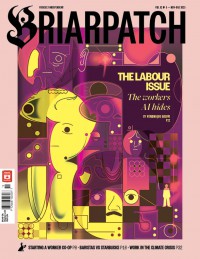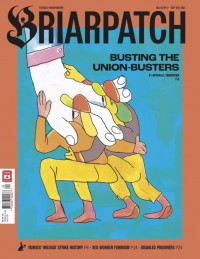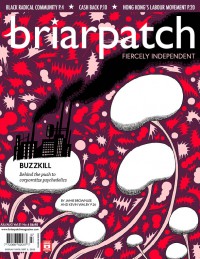The Art of Communication
A community comes together to silently express its collective understanding of violence and silently share its collective hopes.
By Tracey Mitchell
March/April 2005
Movements for social justice have a long history of connection with the arts. Over the past few years, these linkages have only grown and multiplied. We have seen giant puppets take to the streets all over the world. We’ve seen art auctions and photo calendars used as fundraisers. Fringe festivals and other places have become showcases for plays about issues ranging from water privatization to marijuana legalization. And musicians have brought social change and art together in all kinds of genres from folk to hip hop to punk.
Violence against women is one of the many issues that has benefitted from use of different kinds of artistic media to increase public awareness. For the past few years, thousands of women have participated in, and audiences all over the world have enjoyed, productions of Eve Ensler’s The Vagina Monologues. In Saskatchewan this production has been done by students at both universities, and an Aboriginal women’s adaptation was produced by the Saskatchewan Native Theatre Company.
Recently a new group has been experimenting with another kind of theatre to help address the issues and challenges of violence against women. The Coalition Against Sexual Assault (CASA) at the University of Saskatchewan formed in response to two recent assaults on campus. Having achieved considerable success in its first year working with other campus groups to improve the university’s response to sexual assaults and increase safety measures, CASA began to look for ways to address the systemic causes of sexual violence. We also wanted to try something creative and innovative to counter the thoroughly institutional and uninspired response of the university to the trauma of sexual violence.
We grappled with the problem of how to mobilize around emotionally-laden issues that are difficult to get our heads around. I had the sense of having been in a similar situation before, where words are not enough. I had a flashback.
Community Building Approach
In the fall of 2001, I was living in Vancouver and participated in a couple of different events to figure out our individual and community responses to the terrorist attacks that had taken place in the USA and the impending aggressive response. The first was a panel discussion followed by questions and answers. There was a widespread feeling of helplessness and people felt the need to come together to deal with their grief and fear. Yet, this did not happen. Instead, the discussion eventually became heated and community factions grew apparent.
The second post-9/11 public event that I attended was called Reaching Across and was organized by Headlines Theatre in conjunction with a local Muslim Youth Centre. During this session, facilitator David Diamond had participants offer stories from their day-to-day lives about responses to 9/ 11. The audience then selected the story that resonated most with them. In this case, it was the story of a woman who had aroused the anger of her neighbours by putting a peace sign on her apartment door after the terrorist attacks. Under David’s guidance, participants set to work building a scene out of this story, unpacking the fears and desires of the key characters and allowing for audience interventions. This process created a forum for discussing alternative ways that we could respond to like situations.
Reaching Across was a very powerful event for me. It was the first time that I had ever seen interactive or “forum” theatre used for social change. I had the opportunity to witness this process several more times during my year in Vancouver, especially in response to cutbacks by the BC Liberals.
CASA decided to invite Lori Whiteman and Marg Friesen of the Regina Public Schools’ ACT! program to host a forum theatre workshop at the U of S in October 2004. They, along with their teenage daughters (who also helped facilitate the workshop) have been using forum theatre to combat racism in their schools and communities. We were so inspired by what we learned in the workshop and by the potential of this work to build strong communities that we invited Lori and Marg back again to participate in a community event for December 6, the National Day of Remembrance and Action on Violence Against Women.
On December 6, we gathered at the Indian and Metis Friendship Centre for an event called Images and Imaginings: A Ceremony for Our Stolen Sisters. Over 100 men and women came to the event. We shared food and then opened with greetings and prayers from Aboriginal elders.
Silent Theatre
The facilitators used several different techniques to help us tell stories using our bodies to create frozen shapes and silent images. The beauty of this work is that the images and stories can represent completely different things to different people. A woman lying on the ground might be doing yoga, she might be ill, or she might be experiencing domestic violence.
This is important, because when we rely solely on speakers and public discussion, we can never speak to everyone’s experience. This type of theatre allows everyone to have their own reaction or experience based on their own individual background. Audience members are invited to replace actors in order to share their experience with others if they choose, creating a powerful bond among participants. The skill of the facilitator carries us along in a fluid interplay between our own internal experience of a difficult issue and a public representation of our collective understanding and fears.
The facilitator then capitalizes on the different ways that people view the scene by inviting the audience to suggest ways to change the image. In this case, because we were working on the topic of sexual violence, that often meant changing the gender of various characters in the tableau. For example, particular scenes seemed more believable with women in the vulnerable roles rather than men.
In the final stage of our December 6 event, all participants and audience members were invited to create images of hope; these statue images were created with our eyes closed. Opening our eyes revealed to us the images that others had created and how our vision of hope fit with others, as well as how it differed. Through these images and the ability to intervene in scenes and make changes, the audience is engaged in a process of creating images of social change the way they would like to see it happen.
This interactive theatre process was recently used in workshops conducted by the cast and crew of The Vagina Monologues at the U of S to explore themes around oppression. It is also being used by Headlines Theatre in their anti-racism presentation called Gimme the Keys at several locations across Canada, including Scott Collegiate in Regina. Gimme the Keys involves bringing participants from within the community together for a week of workshops to explore personal experiences with racism. Short plays are then developed that reflect the harsh realities in the lives of the cast members. These plays are then performed with an invitation to the audience to intervene and replace actors, with the goal of creating the dialog needed to initiate change.
Why Theatre?
There is a reason, I think, why the performing arts are so important for creating social change. It is because they can engage your whole body, not just your mind. David Diamond expresses this well in an article called Creating Community Based Dialogue. “Art is transformative in a way that didactic lectures are not. I believe that change is motivated from the heart, not the head. Theatre is a powerful tool because it communicates with our hearts.”
In our brief experience with forum theatre, it is clear to our coalition that we have only just scratched the surface. We hope to continue experimenting with this process, perhaps applying it to other issues. We know we have not yet seen the full potential of forum theatre to help heal and strengthen our communities—to reach more peoples’ hearts. As David Diamond says, “The theatre really is a revolutionary rehearsal.”
Tracey Mitchell is studying history and sociology at the University of Saskatoon and is a member of the U of S Coalition Against Sexual Assault.
Readers like you keep Briarpatch alive and thriving. Subscribe today to support fiercely independent journalism.



